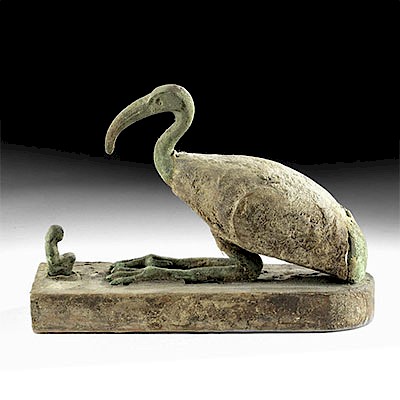Published Byzantine 24K Gold Cross w/ Garnet
Lot 99
About Seller
Artemis Gallery
686 S Taylor Ave, Ste 106
Louisville, CO 80027
United States
Selling antiquities, ancient and ethnographic art online since 1993, Artemis Gallery specializes in Classical Antiquities (Egyptian, Greek, Roman, Near Eastern), Asian, Pre-Columbian, African / Tribal / Oceanographic art. Our extensive inventory includes pottery, stone, metal, wood, glass and textil...Read more
Estimate:
$3,000 - $4,500
Absentee vs Live bid
Two ways to bid:
- Leave a max absentee bid and the platform will bid on your behalf up to your maximum bid during the live auction.
- Bid live during the auction and your bids will be submitted real-time to the auctioneer.
Bid Increments
| Price | Bid Increment |
|---|---|
| $0 | $25 |
| $300 | $50 |
| $1,000 | $100 |
| $2,000 | $250 |
| $5,000 | $500 |
| $10,000 | $1,000 |
| $20,000 | $2,500 |
| $50,000 | $5,000 |
| $100,000 | $10,000 |
| $200,000 | $20,000 |
About Auction
By Artemis Gallery
Oct 31, 2019
Set Reminder
2019-10-31 10:00:00
2019-10-31 10:00:00
America/New_York
Bidsquare
Bidsquare : Fine Antiquities, Asian, Ethnographic Art
https://www.bidsquare.com/auctions/artemis-gallery/fine-antiquities-asian-ethnographic-art-4581
Our Halloween Day auction features classical antiquities, ancient and ethnographic art from cultures encompassing the globe, plus fine art. Artemis Gallery info@artemisgallery.com
Our Halloween Day auction features classical antiquities, ancient and ethnographic art from cultures encompassing the globe, plus fine art. Artemis Gallery info@artemisgallery.com
- Lot Description
Ancient Near East, Byzantium, ca. 5th to 7th century CE. A lovely Byzantine gold cross with a circular garnet cabochon set in a bezel that is centered between the arms of the cross and an integral suspension loop atop. Note how each arm of the cross is elegantly traced with a beaded border. The gold is quite pure - 96% or equivalent to ~24K. Beautiful, religiously symbolic, and absolutely wearable! Size: 1.125" H (2.9 cm); cabochon measures .25" in diameter (0.6 cm); precious metal quality: 96% gold or equivalent to ~24K; total weight: 4.9 grams
The Byzantine period was a time of intense religiosity and immense wealth concentrated in religion. On the backdrop of the Crusades and the split between the Eastern and Western branches of the Church, religious jewelry like this played a significant role. Not only did it symbolize one's status, it also served as a diplomatic tool. Interestingly, Emperor Justinian established laws (later called the Justinian Code) that among other things regulated the wearing of jewelry. He stated that sapphires, pearls, and emeralds were reserved for the emperor; however, every free man was actually entitled to wear a gold ring. This suggests widespread popularity of jewelry. After all, such a law would not have been necessary if jewelry had been a strictly aristocratic luxury. Indeed, wealth abounded in the Byzantine Empire. There were gold mines within its borders. What's more, its geographical location was ideal for trade between the East and the West. Hence, individuals of various pursuits including military officers, traders, as well as high officials reporting to the emperor would all have been able to afford luxurious jewelry.
This cross was recently exhibited and published in catalogue for "Dressed to Kill in Love and War: Splendor in the Ancient World" (February 1 - March 31, 2019 - Academy Museum, Easton, Maryland, USA, fig. 24, p. 9, discussion p. 3). Curator Sarah E. Cox presented it in the "Dressed to Impress" section of this exhibition. According to Dr. Cox, "All classes of women in the ancient world wore jewelry, which was considered both as adornment and as visible evidence of wealth. Many of the surviving pieces, particularly earrings, necklaces, and bracelets, were preserved because they were buried with the deceased. Others were accidentally lost in baths or toilets, or due to the vicissitudes of nature and war."
Provenance: private East Coast, USA collection; Exhibited and published in catalogue for "Dressed to Kill in Love and War: Splendor in the Ancient World" (February 1 - March 31, 2019 - Academy Museum, Easton, Maryland, USA, fig. 24, p. 9, discussion p. 3); ex-Madame Frances Artuner collection, Belgium, acquired in the 1960s
All items legal to buy/sell under U.S. Statute covering cultural patrimony Code 2600, CHAPTER 14, and are guaranteed to be as described or your money back.
A Certificate of Authenticity will accompany all winning bids.
We ship worldwide and handle all shipping in-house for your convenience.
#146269Normal indentations to the cross. Band of granules on upper section of left arm of the cross is now set on a diagonal - still present and attached. Cabochon is excellent. Normal earthen deposits in recesses.Condition
- Shipping Info
-
All shipping is handled in-house for your convenience. Your invoice from Artemis Gallery will include shipping calculation instructions. If in doubt, please inquire BEFORE bidding for estimated shipping costs for individual items.
-
- Buyer's Premium



 EUR
EUR CAD
CAD AUD
AUD GBP
GBP MXN
MXN HKD
HKD CNY
CNY MYR
MYR SEK
SEK SGD
SGD CHF
CHF THB
THB













